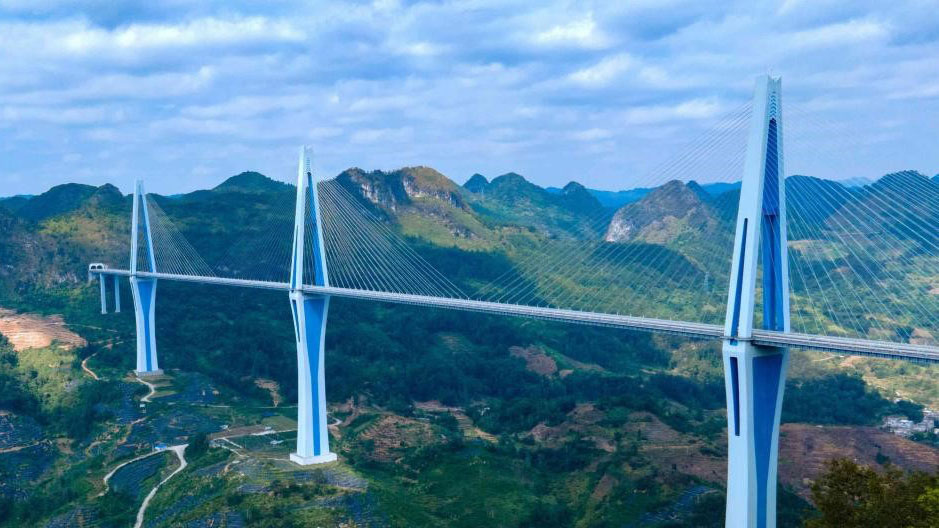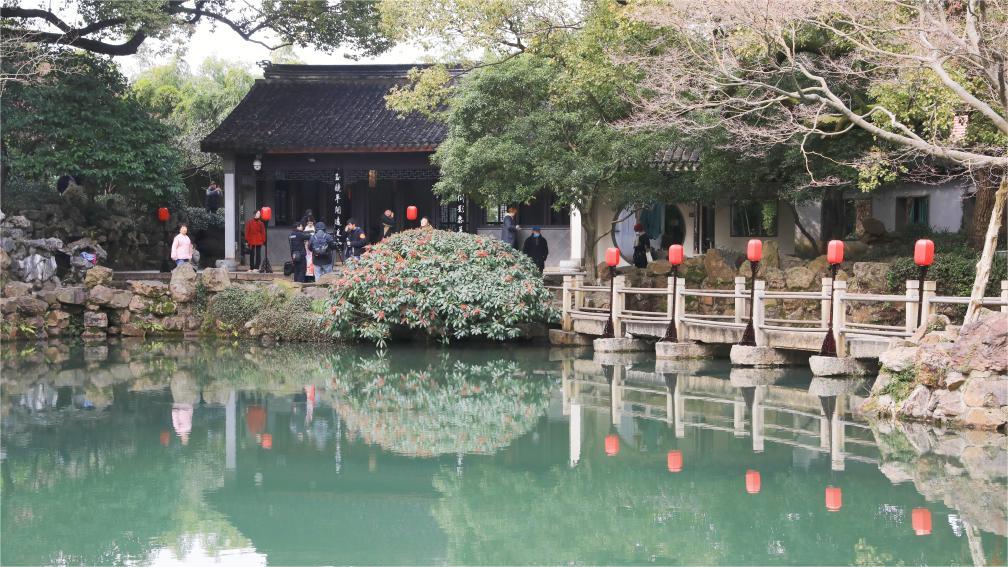Beijing-Tianjin-Hebei coordination nets results

Workers inspect a tunnel that is part of Line 22 of Beijing's urban railway transit network, which passes through Langfang, Hebei province, last month. The line will link the capital's Pinggu district to its downtown area via Yanjiao, an area under the administration of Langfang but located just across the Chaobai River from Beijing. WANG XIAO/XINHUA
Over 10 years ago, daring to hang your clothes out to dry was often a fool's errand in the dusty Luquan district in Shijiazhuang, Hebei province, as they'd likely come indoors dirtier than they were before.
In Luquan, the cement industry reigned supreme thanks to the abundance of limestone. The district has been a major player in providing the fuel for China's massive concrete expansions and infrastructure projects over the past decade. As a result, dust often filled the air.
Located at the foothills of the Taihang Mountains on the western side of the North China Plain, a 10-kilometer-long corridor was home to more than 160 cement enterprises at its peak.
The cement corridor became a significant source of pollution for the city, dragging the air quality of Shijiazhuang down to rank it at the bottom of a list of 74 major Chinese cities from 2013 onward.
However, thanks to strict government action and regulation on sources of pollution, blue skies have returned.

CHINA DAILY
"There is no more dusty weather, and the blue sky is back, " said He Weiying, a 45-year-old who used to work in the cement industry.
Last year, the average concentration of fine particulate matter, or PM2.5, in Hebei dropped to 38.6 micrograms per cubic meter, a decrease of 64.3 percent compared to 2013, and days with good air quality increased by 121 compared to 2013, according to data from the provincial government.
All key cities in the province have risen out of the bottom 10 of the national list for air quality.
"At our museum, we tell the visitors how we achieved this through vivid pictures and detailed stories," said He, who is now a curator at a local museum about the area's industrial history.
The joint and comprehensive campaign against air pollution launched in the Beijing-Tianjin-Hebei region in the past decade has managed to bring about large-scale changes through a series of bold industrial restructuring and upgrading initiatives.
A total of 237 cement and building materials enterprises have been closed, slashing 80 percent of the cement production capacity in Luquan, and the remaining two cement enterprises have undergone continuous upgrades and transformations, said Cui Zhenhong, from the district's bureau of science, industry and information technology.
Hebei Jinyu Dingxin Cement is one of the two remaining cement enterprises in the district.
"Our cement workers are now also environmental workers, and they no longer have to endure a grimy appearance at work, since there has been an improvement in dust reduction," said Liu Keqin, director of the company's energy and environmental protection department.
The company has injected around 1 billion yuan ($138.9 million) in the past 10 years into upgrading technologies and facilities involved in reducing emissions, Liu said, in response to the regional coordinated campaign to cut emissions.
Hebei Jinyu Dingxin Cement even opened a cement museum in 2019 to show how it has developed and transformed over the years.
"Visitors to the museum are often surprised that a cement production base is capable of being clean and beautiful just like an urban park," said Wu Xiangyan, from the company's publicity department.
Around 30,000 students visited the museum last year, she said.
Wu Tao, a Luquan resident and a worker at the cement factory for 21 years has noticed how his surroundings have changed over time.
"I commuted to work on a motorcycle before, passing through stone quarries where dust filled the air. Now, I take a shuttle bus, traveling along the mountain road and watching the hills on the way, which uplifts my mood for work," he said.
The mountain road is a major vertical transportation artery in Luquan, spanning 50 km, with 33 scenic spots and attractions, including a zoo and a mountain forest park that have promoted local tourism since 2018, according to the district government.
With the increased number of tourist attractions and well-connected roads, Luquan has become a hot destination. During the eight-day Spring Festival holiday last month, it had 1.27 million visits, generating nearly 12.69 million yuan in ticket revenue, the district government said.

Workers test chips at an electronics factory in Luquan district of Shijiazhuang, Hebei province, last month. CHINA DAILY
Growing together
The upgrading of the cement industry in Shijiazhuang's Luquan district, along with the environmental improvement, can be seen as a microcosm of the achievements in the coordinated development of the Beijing-Tianjin-Hebei region.
The development of the region is a national strategy put forward by President Xi Jinping in February 2014, aiming to achieve better integration and more balanced growth in the area.
In June 2015, the Central Committee of the Communist Party of China and the State Council issued the Outline of the Plan for the Coordinated Development of the Beijing-Tianjin-Hebei Region, clearly defining Hebei's positioning including as an experimental zone for industrial transformation and upgrading, and an ecological and environmental support zone for the Beijing-Tianjin-Hebei region.
In response, Hebei has taken a series of measures to further accelerate the transformation in six major industries, including steel, coal, cement and thermal power, in the past decade. Luquan's transformation of the cement industry is just one successful example.
In the coordinated development, relieving Beijing of functions nonessential to its role as the national capital has been a key target, which has led to the relocation of many industries and sources outside of the capital.
"Beijing has played a pivotal role in driving regional development, transitioning from industrial transfer to collaborative industrial chain development, thereby expanding industrial output together with the other two," said Liu Bozheng, deputy director of the Beijing office overseeing the integration of the Beijing-Tianjin-Hebei region.
As of the end of December, enterprises in Beijing's high-tech area of Zhongguancun had established more than 10,000 branches in Tianjin and Hebei province.
Hebei has also grasped opportunities to carry out initiatives to attract companies and nurture its own distinctive industries.
"We have observed an increasingly clear trend that Beijing is leading in relocations with Tianjin and Hebei integrating, and Beijing and Tianjin are leading in development and research with Hebei doing the transformation in research outcomes," Yan Jihong, mayor of the city of Baoding in Hebei and a deputy to the National People's Congress, told Outlook Weekly news magazine.
Hebei has attracted around 43,000 companies, and the industrial structure has been upgraded in this process, according to the provincial development and reform commission, the provincial top economic planning body.
It has nurtured 12 leading industries and 107 distinctive industries at the county level, and the proportion of the value-added of high-tech industries in industrial enterprises above a designated size (those with 20 million yuan or more in annual revenue) has increased to 21.4 percent from 13.1 percent in 2014, indicating a high-quality growth trend in high-tech industries, data from the commission showed.
"We have prepared to integrate with the relocation industries from Beijing and Tianjin in various ways such as issuing preferential policies for talent and finance, and improving supplementary facilities in industrial production and living," said Wu Lijun, deputy director of the management committee of the Luquan Economic Development Zone.
"So far, at least 50 companies from Beijing and Tianjin have thrived in the zone, which has contributed to the city's economic growth and technological innovation," Wu said.
As a hub for the electronic information industry in Shijiazhuang, the Luquan Economic Development Zone is home to 1,060 electronic information enterprises, he said, adding that in 2023, total operating income surpassed 85 billion yuan, marking a year-on-year growth of 34.9 percent.
Hebei Far East Communication System Engineering, a company in the zone, has participated in the regional coordinated development by enhancing regional collaborative innovation and exploring the regional market, said Zhang Songyi, vice-president of the company.
It has collaborated with famous universities in the region such as Beihang University, the Beijing Institute of Technology and Yanshan University to jointly advance research and development in areas such as 5G, big data and artificial intelligence, Zhang said.
The company has played a major role in the construction of digital and intelligent applications for rail transit in the Beijing-Tianjin-Hebei region, he said, taking as an example its independently developed LTE broadband digital trunked radio system that was successfully applied on Beijing's Yanfang metro line in 2017.
Hebei Shenyue Soft, a high-tech internet enterprise in Luquan, is another example of how private sector companies are benefiting from regional coordinated development.
The company has benefitted from preferential policies and the promising future of regional coordination, and has relocated its headquarters from Beijing to Shijiazhuang. As a result, it has grown from a company with a dozen employees to over 1,500 with 13 branches in China, said Luo Jun, head of the Hebei Shenyue Soft's human resources department.
"With the improving transportation network in the region, it's easier to commute between Beijing and Shijiazhuang," said Luo, who travels back to Beijing from Hebei with his family every weekend.

A tanker docks at a smart, zero-carbon pier in Tianjin Port last month. The pier uses artificial intelligence and autonomous vehicles to increase the efficiency of loading and unloading containers. ZHAO ZISHUO/XINHUA
Shared public service
Railways in the Beijing-Tianjin-Hebei region now extend for more than 11,000 km, up more than 30 percent since 2013, while expressways run for nearly 11,000 km, more than 40 percent farther than in 2013, according to official data.
The coordinated development in the region has grown into a new driving force for China's development.
"The regional economic output has reached 10.4 trillion yuan, 1.9 times that of 2013, indicating a continuous enhancement of the overall regional strength," said Liu Bozheng from the Beijing office overseeing the integration of the Beijing-Tianjin-Hebei region.
Residents in the three places have also witnessed broader shared public services such as in medical treatment and education, with over 40,000 senior residents from Beijing and Tianjin choosing to live in community nursing homes in Hebei, according to the Beijing Bureau of Statistics.
Over the past decade, more than 200 primary and secondary schools in Beijing and Tianjin have established cooperative education ties with more than 200 schools in Hebei, and 15 universities in Beijing will establish new campuses in the Xiong'an New Area, according to the Hebei government.
"The entry of these 15 universities will bring high-quality talent and technological resources to Xiong'an, and even to the higher education sector of Hebei province," Wang Huan'an, deputy director of the development planning office at Capital Normal University, told an industrial forum in Beijing.
In April 2017, China announced the plan to establish Xiong'an New Area, located about 100 km from Beijing. It aims to become a significant part of the world-class Beijing-Tianjin-Hebei city cluster and plans to take over Beijing's non-capital functions and provide a Chinese solution to "big city malaise", such as overcrowding, pollution and traffic congestion.
Du Juan contributed to this story.
Photos
Related Stories
- China's Tianjin launches 1st roadway for intelligent connected vehicles
- Explainer: How port cooperation helps enterprises in Beijing-Tianjin-Hebei region go abroad
- Lei Feng spirit echoes in north China's Tianjin
- How China's '15-minute Community Life Circle' initiative improves people's lives
- Beijing eyes 100 more smart factories, digital workshops
- Integrated transportation hub of Beijing sub-center under construction
Copyright © 2024 People's Daily Online. All Rights Reserved.









